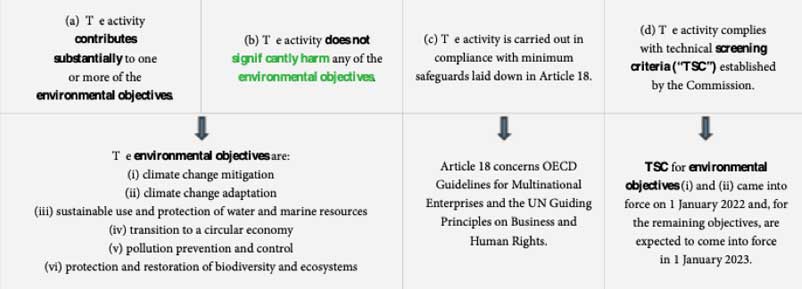Arthur Cox – Speak my Language
ARE YOU TAXONOMY-ALIGNED?
We recently looked at the EU’s “Fit for 55” package of legislative proposals, focusing on anticipated changes to the Energy Efficiency and Energy Performance of Buildings Directives. Since then, war in Ukraine led the European Commission to up efficiency targets again, in REPowerEU.
THIS MONTH we look at a related topic. A significant development of recent years is that tackling climate change broadened out from energy and emissions-focused law to sustainable finance. The EU Taxonomy Regulation is a tool underpinning this.
WHAT IS THE TAXONOMY?
It is a classification system for determining whether an economic activity is environmentally sustainable. An economic activity qualifies as environmentally sustainable where it meets four criteria (a) to (d) shown in the table below.
WHAT DOES THE TAXONOMY SAY ABOUT CONSTRUCTION?
There is significant detail on construction. The TSC are broken down into sectors, which are further broken down into activities. For example, “construction and real estate” is a sector with activities including construction of new buildings; renovation of existing buildings; installation, maintenance and repair of (for example) devices for measuring, regulating and controlling the energy performance of buildings, and EV charging stations; and acquisition and ownership of buildings.
For each activity, the TSC elaborates on what is meant by “substantial contribution” and “do no significant harm”.
For example, to be ‘Taxonomy-aligned’, “construction of new buildings” would have to meet several criteria, one of which (under climate change mitigation) is that the Primary Energy Demand defining the energy performance of the building is at least 10% lower than the threshold set for the nearly zero-energy building requirements in national measures.
TSC made so far are in a Delegated Act applicable since 1 January 2022. A further Delegated Act for the remaining environmental objectives is expected to come into force on 1 January 2023.
The Commission developed an EU Taxonomy Compass to help navigate the TSC, available here:
https://ec.europa.eu/sustainable-finance-taxonomy/tool/index_en.htm

IS IT MANDATORY TO COMPLY WITH THE TAXONOMY?

Construction and Engineering
The EU Taxonomy Regulation applies to:
– measures (adopted by Member States or the EU) that set out requirements for financial market participants or issuers in respect of financial products or corporate bonds that are made available as environmentally sustainable. These measures include, for example, the EU Sustainable Finance Disclosures Regulation (“SFDR”),
– financial market participants that make available financial products, and
– undertakings subject to the obligation to publish a non-financial statement or a consolidated non-financial statement under the EU Non-Financial Reporting Directive (“NFRD”), which are required to disclose how and to what extent their activities are associated with economic activities that qualify as environmentally sustainable under the EU Taxonomy Regulation. (The NFRD currently applies to large public interest entities with more than 500 employees (and the scope of the Irish legislation is wider) but, under the proposed Corporate Sustainability Reporting Directive, the scope will be extended to all large companies and all EU listed companies (excluding micro-enterprises).)
IF I DO NOT HAVE TO COMPLY WITH THE TAXONOMY, WHAT IS ITS RELEVANCE?

Finance
Even if the EU Taxonomy Regulation is not binding on your business, lenders and investors will likely be required or aiming to ensure their parts of their portfolios are Taxonomy-aligned.
For example, a green bond issuer may seek to target Taxonomy-aligned construction projects / real estate assets in which to invest bond proceeds. At EU level, a proposal for a voluntary green bond standard (which would involve a requirement for Taxonomy-alignment) is close to being finalised. A large real estate investment trust may be required to report on the extent to which its activities are Taxonomy-aligned.
The financial sector is subject to significant new disclosure requirements under the SFDR. A Corporate Sustainability Due Diligence Directive is also undergoing the legislative process. The Taxonomy provides common standards to underpin these new obligations.
Ultimately, there is a wide consensus that entities ignoring ESG (environmental, social and governance) principles will be left behind. Investors or funders are increasingly focused on ascertaining the ESG credentials of projects, in particular the degree of Taxonomy-alignment, as are purchasers / tenants.
CONSTRUCTION SECTOR PRESPECTIVE

Review the Taxonomy, particularly the TSC. “Construction and real estate” references some familiar concepts (like EPCs and ISO and CEN standards) so carry out a label matching audit against what you are already doing. Also consider all the TSC: you may be interested in “construction of new buildings” and “renovation of buildings”; bear in mind that purchasers or asset managers will look also to “acquisition and ownership of buildings.”
In terms of contracts, a starting point is aligning the technical specification with the Taxonomy. The proposed new NEC clause X29 provides (among other things) for Climate Change Requirements to be included in the Scope and a Climate Change Execution Plan to be agreed.
The technical specification alone, however, is unlikely to drive the full extent of carbon savings that can be made – which is ultimately what the Taxonomy is about.
Innovative contractual mechanisms are being negotiated and road-tested. We identify three current themes.
First, mechanisms should empower the Contractor and supply chain to bring carbon savings. For example, one approach involves setting a project carbon budget with an independent administrator to monitor and report on performance linked to payments and liquidated damages. (A carbon budget would set the carbon tonne equivalent of greenhouse gas emissions that an asset would have to stay within during the entire lifecycle, from procurement of materials to decommissioning). An example has been developed by the Chancery Lane Project for use with the JCT Design and Build Contract. The intent is to incentivise relevant parties to sustainably select and procure the materials to be used. Clauses might also, for example, prevent use of materials the manufacture of which has involved modern slavery.
Second, beware of unachievable obligations being shoe-horned into contracts. An advantage of using ESG-driven obligations is that it requires parties to interrogate what will be involved in implementation – and to price that – upfront. Contractual mechanisms should also provide a roadmap for allowing the parties to introduce innovative solutions as a project progresses. The same applies to enforcement: a framework of early warnings and mechanisms for resolving potential breaches and bringing the project back on track may be preferable to termination (or increasing lending rates), outcomes unlikely to reduce carbon. ESG driven obligations need to be capable of being passed down the supply chain, so interrogating how to approach them from the outset is critical.
 A third theme is supply chain engagement: consultants, contractors and sub-contractors will identify how to get optimal results. They may bring further carbon savings through their own innovative working practices, which could end up making the difference to the success of a project. The supply chain is also vital in due diligence and emissions-related data collection, a challenging task. A lender and employer will value a supply chain skilled in this area because reliable data will be important for demonstrating green credentials of an asset and meeting the regulatory requirements mentioned above. Obligations around data collection, disclosure and reporting will likely feature.
A third theme is supply chain engagement: consultants, contractors and sub-contractors will identify how to get optimal results. They may bring further carbon savings through their own innovative working practices, which could end up making the difference to the success of a project. The supply chain is also vital in due diligence and emissions-related data collection, a challenging task. A lender and employer will value a supply chain skilled in this area because reliable data will be important for demonstrating green credentials of an asset and meeting the regulatory requirements mentioned above. Obligations around data collection, disclosure and reporting will likely feature.
Ultimately, contracts should incorporate tools to support parties in seizing every opportunity to reduce carbon, vital to avoid harmful climate change. Large entities are assessing their supply chains on the basis of ESG criteria and so, whatever its size, a business must be capable of credibly vouching for ESG credentials. The Taxonomy is one of the main tools to support this. If nothing else, your next contract may oblige you to align!
The authors would like to thank Máté Tóth for his contribution to this article.

